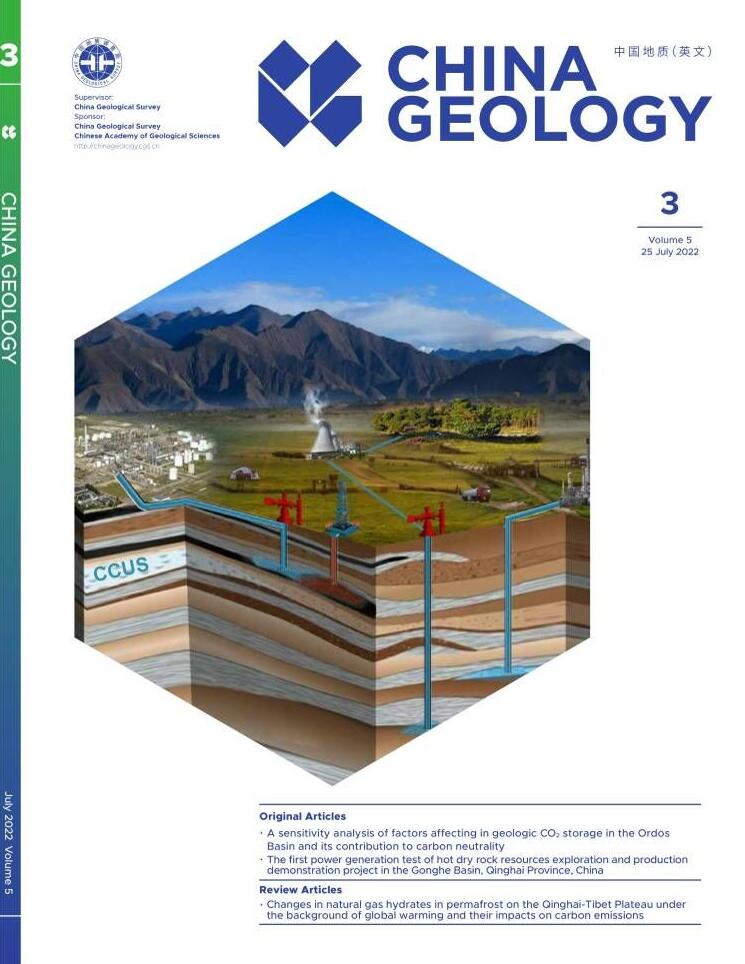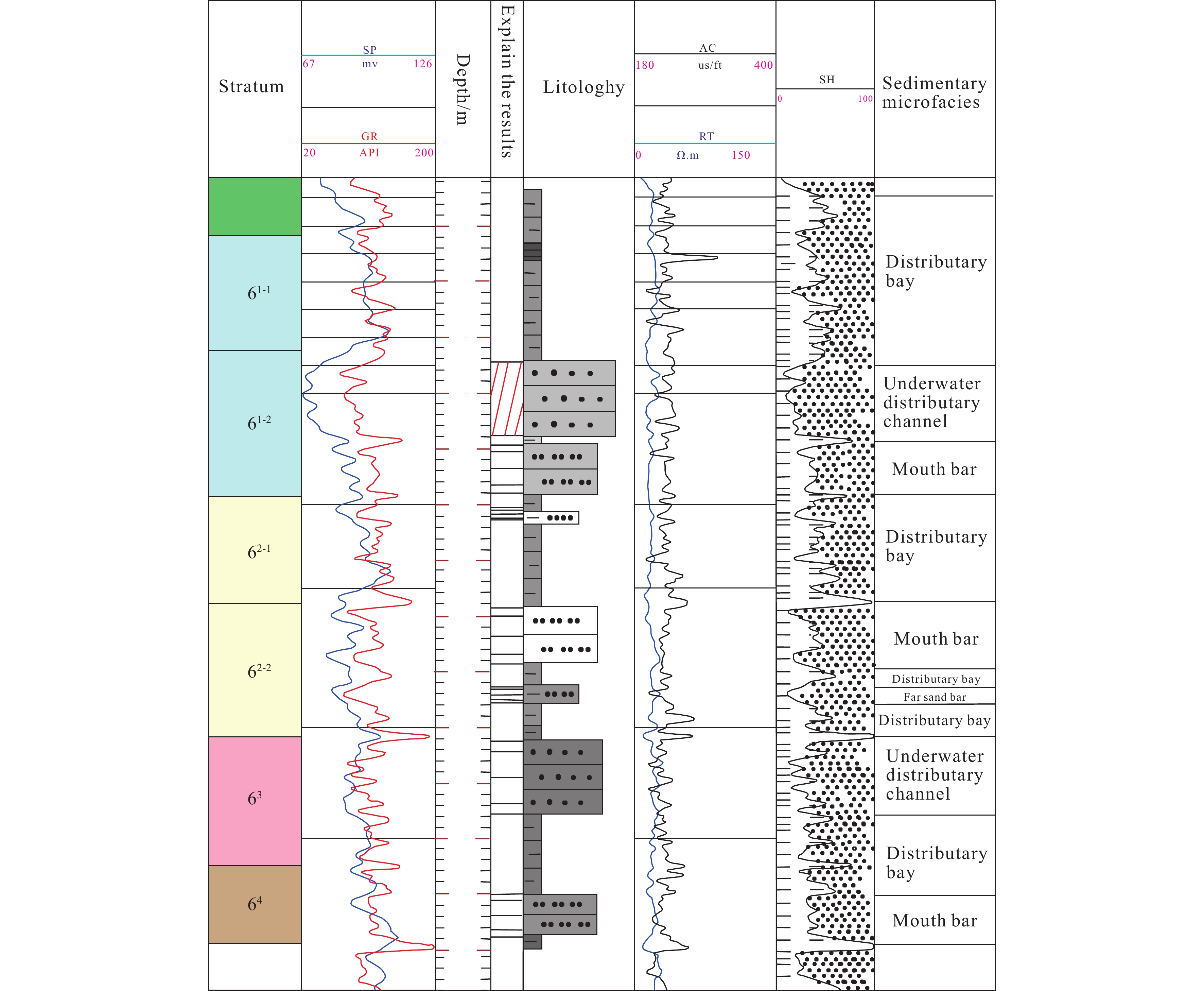| Citation: | Shi-xin Dai, Yan-jiao Dong, Feng Wang, Zhen-han Xing, Pan Hu, Fu Yang, 2022. A sensitivity analysis of factors affecting in geologic CO2 storage in the Ordos Basin and its contribution to carbon neutrality, China Geology, 5, 359-371. doi: 10.31035/cg2022019 |
A sensitivity analysis of factors affecting in geologic CO2 storage in the Ordos Basin and its contribution to carbon neutrality
-
Abstract
To accelerate the achievement of China’s carbon neutrality goal and to study the factors affecting the geologic CO2 storage in the Ordos Basin, China’s National Key R&D Programs propose to select the Chang 6 oil reservoir of the Yanchang Formation in the Ordos Basin as the target reservoir to conduct the geologic carbon capture and storage (CCS) of 100000 t per year. By applying the basic theories of disciplines such as seepage mechanics, multiphase fluid mechanics, and computational fluid mechanics and quantifying the amounts of CO2 captured in gas and dissolved forms, this study investigated the effects of seven factors that influence the CO2 storage capacity of reservoirs, namely reservoir porosity, horizontal permeability, temperature, formation stress, the ratio of vertical to horizontal permeability, capillary pressure, and residual gas saturation. The results show that the sensitivity of the factors affecting the gas capture capacity of CO2 decreases in the order of formation stress, temperature, residual gas saturation, horizontal permeability, and porosity. Meanwhile, the sensitivity of the factors affecting the dissolution capture capacity of CO2 decreases in the order of formation stress, residual gas saturation, temperature, horizontal permeability, and porosity. The sensitivity of the influencing factors can serve as the basis for carrying out a reasonable assessment of sites for future CO2 storage areas and for optimizing the design of existing CO2 storage areas. The sensitivity analysis of the influencing factors will provide basic data and technical support for implementing geologic CO2 storage and will assist in improving geologic CO2 storage technologies to achieve China’s carbon neutralization goal.
-

-
References
Alkan H, Cinar Y, Lker EB. 2010. Impact of capillary pressure, salinity and in situ conditions on CO2 injection into Saline Aquifers. Transport in Porous Media, 84(3), 799–819. doi: 10.1007/s11242-010-9541-8. Bachu S. 2000. Sequestration of CO2 in geological media: criteria and approach for site selection in response to climate change. Energy Conversion and Management, 41(9), 953–970. doi: 10.1016/S0196-8904(99)00149-1. Bachu S. 2003. Screening and ranking of sedimentary basins for sequestration of CO2 in geological media in response to climate change. Environmental Geology, 44(3), 277–289. doi: 10.1007/s00254-003-0762-9. Chen B, Xiao HL, Li JM, Wang XZ. 2018. Advances in research on carbon capture, utilization and storage. Applied Chemical Industry, 47(3), 589–592. doi: 10.16581/j.cnki.issn1671-3206.2018.03.028. Ershadnia R, Wallace CD, Soltanian MR. 2020. CO2 geological sequestration in heterogeneous binary media: Effects of geological and operational conditions. Advances Geo-Energy Research, 4(4), 392–405. doi: 10.46690/ager.2020.04.05. Gao ZD. 2017. Characteristics of Chang 6 low-permeability reservoir in Huaziping area of Xingzichuan Oilfield, Northern Shaanxi. Journal of Xi’an Shiyou University (Natural Science Edition), 32(6), 54–58. doi: 10.3969/j.issn.1673-064X.2017.06.007. Goodarzi S, Settari A, Keith D. 2012. Geomechanical modeling for CO2 storage in Nisku aquifer in Wabamun Lake area in Canada. International Journal of Greenhouse Gas Control, 10(10), 113–122. doi: 10.1016/j.ijggc.2012.05.020. Groves DI, Santosh M, Deng J, Wang Q, Yang L, Zhang L. 2020. A holistic model for the origin of orogenic gold deposits and its implications for exploration. Mineralium Deposita, 55(2), 275–292. doi: 10.1007/s00126-019-00877-5. Jiang HY, Shen PP, Wang NJ, Li ZP, Qi LR, Yu SR. 2007. Policies for CO2 emission reduction and prospects for CO2 gedlogical storage underground. Sino-Global Energy, 2007(05), 7–13. doi: 10.3969/j.issn.1673-579X.2007.05.002. Ke YB, Li YL, Zhang W, Dong JX, Fang Q, Wu RH. 2012. Impact of halite precipitation on CO2 injection into saline aquifers: A case study of Jianghan Basin. Geological Science and Technology Information, 31(3), 109–115. doi: 10.3969/j.issn.1000-7849.2012.03.017. Lei XL, Zhao JZ, Liu HW, Li WH. 2008. Petroleum accumulation and distribution in triassic Chang-6 reservoir in Eastern North Shaanxi slope, Ordos Basin. Xinjiang Petroleum Geology, 29(6), 4. Li B. 2014. Research on Oil Reservoir Characteristics of Chang 6 Oil Layer Formation in the north of Ansai Oilfield Huaziping Area in Odros Basin. Xi’an, Xi’an Shiyou University, Ph. D thesis, 1–59 (in Chinese wish English abstract). doi: 10.7666/d.Y2754690. Li SX, Chu MJ, Wang TF, Zhang WX, Zhou XP. 2017. Features of formation water and implications for hydrocarbon accumulation in Chang 6 pay zone, Jiyuan area, Ordos Basin. China Petroleum Exploration, 22(05), 43–53. doi: 10.3969/j.issn.1672-7703.2017.05.005. Li C, Zhang KN, Xu YQ, He QC. 2011. Analysis of impacts of variation in injection rate on the potential of proposed reservoir for CO2 geological sequestration. Shanghai Land and Resources, 32(1), 24–27+32. doi: 10.3969/j.issn.2095-1329.2011.01.006. Li GJ, Zhang J. 2011. Progress and implications of carbon dioxide capture and geological storage projects. Sino-Global Energy, 16(6), 12–16. Li Q, Cai BF, Chen F, Liu GZ, LIU LC. 2019. Review of environmental risk assessment methods for carbon dioxide geological storage. Environmental Engineering, 37(02), 13–21. doi: 10.13205/j.hjgc.201902003. Ling LL, Xu YQ, Wang YS, Zang KN. 2013. Application of numerical simulation to pilot project of CO2 geological sequestration. Rock and Soil Mechanics, 34(07), 2017–2022+2030. doi: 10.16285/j.rsm.2013.07.026. Ma X, Li XF, Wen DG, Luo XW, Diao YJ, Yang GD, Yin SG, Cao W. 2021. A study of the potential of field-scale of CO2 geological storage and enhanced water recovery in the eastern Junggar area of Xinjiang. Hydrogeology and Engineering Geology, 48(6), 196–205. doi: 10.16030/j.cnki.issn.1000-3665.20201043. Mallapaty S. 2020. How China could be carbon neutral by midcentury. Nature, 586(7830), 482–483. doi: 10.1038/d41586-020-02927-9. Pruess K, Oldenburg CM, Moridis GJ. 1999. TOUGH2 User’s Guide Version 2. Office of Scientific and Technical Information Technical Reports. doi: 10.2172/751729. Salvia M, Reckien D, Pietrapertosa F, Eckersley P, Heidrich O. 2021. Will climate mitigation ambitions lead to carbon neutrality? An analysis of the local-level plans of 327 cities in the EU Renewable and Sustainable Energy Reviews, 135, 110253. doi: 10.1016/j.rser.2020.110253. Wen DG, Guo JQ, Zhang SQ, Xu TF, Jia XF, Li XF, Fan JJ, Zhang H, Diao YJ, Hu QY. 2014. The progress in the research on carbon dioxide geological storage in China. Geology in China, 41(5), 1716–1723. Wei L, Saaf F. 2009. Estimate CO2 storage capacity of the Johansen formation: Numerical investigations beyond the benchmarking exercise. Computational Geosciences, 13(4), 451. doi: 10.1007/s10596-008-9122-x. Wang L. 2014. Numerical Simulation of CO2 Geological Sequestration of Shanxi Formation in Yulin Area, Ordos Basin. Xi’an, Northwest University, Ph. D thesis, 1–90 (in Chinese wish English abstract). doi: CNKI: CDMD: 2.1014.253534. Wiese B, Nimtz M, Klatt M, M Kühn. 2010. Sensitivities of injection rates for single well CO2 injection into saline aquifers. Chemie der Erde-Geochemistry, 70, 165–172. doi: 10.1016/j.chemer.2010.05.009. Wang F, Dai SX, Zhu W, H P, Gong YF. 2020. Migration law of CO2 storage in low-permeability reservoirs— Taking Ordos Basin as an example. Geology in China, 1-18 (in Chinese wish English abstract). http://kns.cnki.net/kcms/detail/11.1167.P.20200929.1103.004.html Xu T. 2001. Modeling multiphase non-isothermal fluid flow and reactive geochemical transport in variably saturated fractured rocks: 1. Methodology. American Journal Ofence, 301(1), 16–33. doi: 10.2475/ajs.301.1.16. Xu T, Sonnenthal E, Spycher N, Pruess K. 2006. TOUGHREACT—A simulation program for non-isothermal multiphase reactive geochemical transport in variably saturated geologic media: Applications to geothermal injectivity and CO2 geological sequestration. Computers and Geosciences, 32(2), 145–165. doi: 10.1016/j.cageo.2005.06.014. Xu T, Tian H, Zhu H, Cai JC. 2022. China actively promotes CO2 capture, utilization and storage research to achieve carbon peak and carbon neutrality. Advances Geo-Energy Research, 6(1), 1–3. doi: 10.46690/ager.2022.01.01. Xue YQ, Xie CH. 2007. Numerical Simulation of Groundwater. Beijing, Sciences Press, 121-125. (in Chinese). Yang GD. 2015. Study on the Mechanism of Carbon Dioxide Geological Storage in Ordos Basin. Wuhan, China University of Geosciences, Master thesis, 1–125 (in Chinese wish English abstract). Zhang EY. 2012. Introduction to the CO2 geosequestration demonstration project in the Otway Basin in Australia. Hydrogeology and Engineering Geology, 39(2), 131–137. doi: 10.16030/j.cnki.issn.1000-3665.2012.02.020. Zhang TJ, Zhang JL, He F. 2016. Analysis to the main factors to control oil reservoir formation of Chang 6 reservior in Huaziping area, Ordos Basin. Inner Mongolia Petrochemical, 42(8), 61–63. Zhang ZX. 2018. Numerical simulation of CO2 leakage along faults from geologic carbon dioxide sequestration. Hydrogeology and Engineering Geology, 45(2), 109–109. doi: 10.16030/j.cnki.issn.1000-3665.2018.02.17. Zeng RS, Sun S, Chen DZ, Duan ZH. 2004. Decrease carbon dioxide emission into the atmosphere—underground disposal of carbon dioxide. Bulletin of National Natural Science Foundation of China, 18(04), 6–10. doi: 10.16262/j.cnki.1000-8217.2004.04.003. Zhang ZM. 2015. The Researching of the Four-property Relationship and Pool Characteristics of Chang 6 Oil-bearing in South Huaziping area of Ansai Oilfield. Xi’an, Northwest University, Ph. D thesis, 1–108 (in Chinese wish English abstract). Zhao RR, Meng QH, Cheng JM. 2012. Fluid migration modeling of CO2 injection in deep saline aquifers-A case study of the Sanzhao depression, Songliao Basin. Rock and Soil Mechanics, 33(4), 1247–1252. doi: 10.16285/j.rsm.2012.04.023. Zhao XS, Yang H, Chen LL, Wu B, Kang YL, Jiang SJ, Wang J, Tang RJ, Wang H. 2019. Analysis of CO2 flooding and storage potential of Chang 6 reservoir in Huaziping area of Yanchang Oilfield. Journal of Xi’an Shiyou University (Natural Science Edition), 34(01), 62–68. doi: 10.3969/j.issn.1673-064X.2019.01.009. Zhang MY, Wang Y, Ren J. 2017. Distribution of CO2 in deep saline aquifers composed of alternating layers. Advances in Science and Technology of Water Resources, 37(01), 84–89+94. doi: 10.3880/j.issn.1006-7647.2017.01.015. Zheng F, Shi XQ, Wu JC, Zhao L, Chen Y. 2014. Global parametric sensitivity analysis of numerical simulation for CO2 geological sequestration in saline aquifers: A case study of Yancheng formation in Subei Basin. Journal of Jilin University (Earth Science Edition), 44(01), 310–318. doi: 10.13278/j.cnki.jjuese.201401209. Zheng YR, Qu HJ, Feng YW, Wang Y, Wang L, Li M. 2011. Microscopic pore structure characteristics of Chang 6 reservoir in H area of Ansai Oilfield. Lithologic Reservoirs, 23(05), 28–32. doi: 10.3969/j.issn.1673-8926.2011.05.006. Zhou QL, Birkholzer RT, Mehnert RE, Lin RF, Zhang RK. 2010. Modeling basin- and plume-scale processes of CO2 storage for full-scale deployment. Ground Water, 48(4), 494–514. doi: 10.1111/j.1745-6584.2009.00657.x. -
Access History

-
Figure 1.
a‒tectonic framework in China showing the spatial location of the Ordos Basin (modified from Groves DI et al., 2020); b‒structure-outline map of the Ordos Basin (modified from Li SX et al., 2017).
-
Figure 2.
Geological profile of the Huaziping area.
-
Figure 3.
The histogram of the Chang 6 oil reservoir.
-
Figure 4.
Profile of the oil reservoir of the Huaziping area (modified from Wang F et al., 2020).
-
Figure 5.
Sand body thickness profile of the Huaziping area.
-
Figure 6.
The core samples of well H303-14, Chang 6, Huaziping.
-
Figure 7.
A diagram of the CO2 perfusion radial well flow model (modified after Wang F et al., 2020).
-
Figure 8.
Distribution of saturation and the concentration of CO2 dissolved in water after 100 years of CO2 storage.
-
Figure 9.
a‒curve of dissolved CO2 in water; b‒curve of CO2 gas saturation.





 DownLoad:
DownLoad:







